Arytenoid muscle
| Arytenoid muscle | |
|---|---|
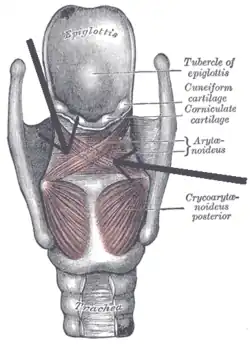 Muscles of larynx. Posterior view. Oblique arytenoid: The "X" in the center. Transverse arytenoid: Bands underneath the "X". Aryepiglotticus: Wraps around back. | |
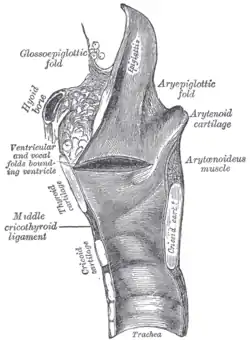 | |
| Details | |
| Origin | Arytenoid cartilage on one side |
| Insertion | Arytenoid cartilage on opposite side |
| Artery | superior laryngeal artery |
| Nerve | recurrent laryngeal branch of the vagus |
| Actions | approximate the arytenoid cartilages (close rima glottis) |
| Identifiers | |
| Latin | Musculus arytaenoideus |
| TA98 | A06.2.08.012 A06.2.08.010 |
| TA2 | 2203, 2205 |
| FMA | 46582 |
| Anatomical terms of muscle | |
The arytenoid muscle /ærɪˈtiːnɔɪd/ is a single muscle of the larynx. It passes from one arytenoid cartilage to the opposite arytenoid cartilage. It has oblique and transverse fibres. It is supplied by the recurrent laryngeal nerve. It approximates the arytenoid cartilages. Continuous electromyography may be used during neck surgeries such as thyroidectomy.
Structure
The arytenoid muscle fills the posterior concave surface of the arytenoid cartilage. It arises from the posterior surface and lateral border of one arytenoid cartilage. It is inserted into the corresponding parts of the opposite arytenoid cartilage.
It consists of oblique and transverse fibres.
Nerve supply
The arytenoid muscle is supplied by the recurrent laryngeal nerve, a branch of the vagus nerve (CN X).[1] This is a bilateral supply.[2]
Function
The arytenoid muscle approximates the arytenoid cartilages. This closes the aperture of the glottis, especially at its back part to eliminate the posterior commissure of the vocal cords.
Clinical significance
Electromyography
Function of the arytenoid muscle is a good method to determine function of the recurrent laryngeal nerve.[1] Continuous electromyography of the arytenoid muscle can provide confidence to surgeons that the recurrent laryngeal nerve is not damaged during neck surgeries, such as thyroidectomy.[1]
Other animals
The arytenoid muscle is found in many animals, including dogs.[2]
Additional images
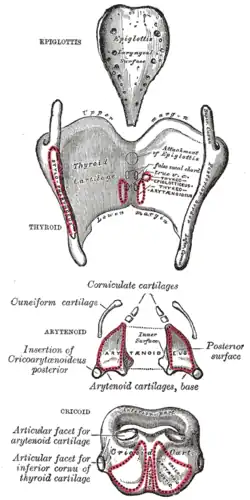 The cartilages of the larynx. Posterior view.
The cartilages of the larynx. Posterior view.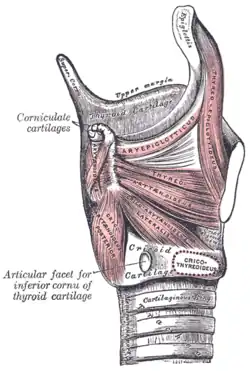 Muscles of larynx. Side view. Right lamina of thyroid cartilage removed.
Muscles of larynx. Side view. Right lamina of thyroid cartilage removed. Aryepiglotic muscle
Aryepiglotic muscle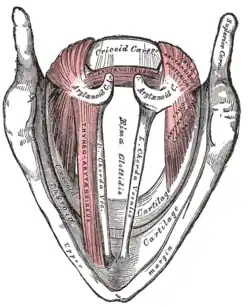 Muscles of the larynx, seen from above.
Muscles of the larynx, seen from above.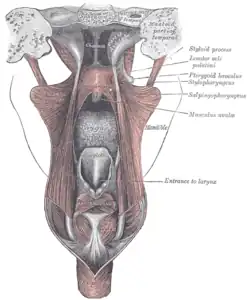 Dissection of the muscles of the palate from behind.
Dissection of the muscles of the palate from behind.
References
 This article incorporates text in the public domain from page 1082 of the 20th edition of Gray's Anatomy (1918)
This article incorporates text in the public domain from page 1082 of the 20th edition of Gray's Anatomy (1918)
- 1 2 3 Li, Peng; Liang, Qing-Zhuang; Wang, Dong-Lai; Han, Bin; Yi, Xin; Wei, Wei (October 2019). "Modified arytenoid muscle electrode recording method for neuromonitoring during thyroidectomy". Gland Surgery. 8 (5): 469–476. doi:10.21037/gs.2019.08.07. ISSN 2227-684X. PMC 6842767. PMID 31741877.
- 1 2 隆一, 相原 (1991). "イヌ披裂筋の構造と運動神経支配に関する研究". 日本耳鼻咽喉科学会会報. 94 (6): 805–816. doi:10.3950/jibiinkoka.94.805. PMID 1715914.